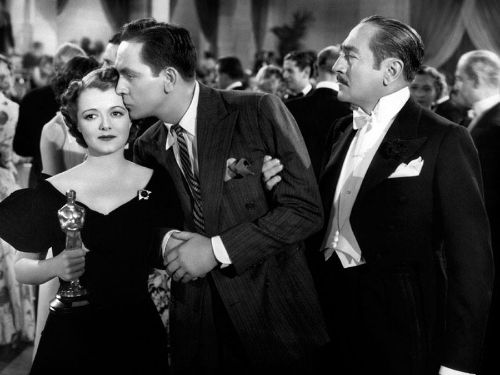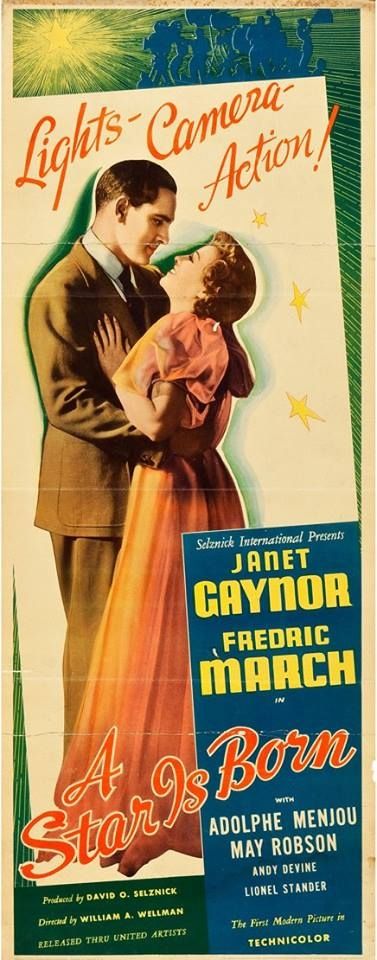The following is a transcript of my presentation on A Star is Born, which was screened at the Park Ridge Public Library on March 30, 2017. Despite being a rainy night, over sixty patrons attended the screening. Had we issued comment cards, Fredric March would’ve received high marks. Several in the audience– who had never seen it before– were deeply affected by the film.
A Star is Born (1937) is not a remake of What Price Hollywood? (1932), although it does share similar story elements, most notably the star who is on the rise while another is on the decline. The film is largely an original work based on an idea by director William Wellman. He had been shopping it around and finally convinced independent producer David Selznick to invest in the story. The property was originally called It Happened in Hollywood, which became the name of another film made at Columbia—one we will see next week. What emerged from this collaboration between Wellman and Selznick was one of the most famous of all movies about movies. A Star is Born is one of the great films of the 1930s with iconic images.
The most comprehensive record of this film’s production can be found in Ronald Haver’s David O. Selznick’s Hollywood, which is one of the outstanding books on film history. In it, Haver writes, “The lore of the town was rife with successes, has-beens, comebacks, ruined marriages, and tragic deaths, and after years and years of retelling and being gossiped about and clucked over, these events and people took on a kind of romantic patina, becoming the authentic legends of Hollywood, making winners out of losers and giving some of them an immortality that transcend anything they might actually have done in pictures. A Star is Born is the closest thing we have to an ideal of the movies: what they meant to the people who worked in them and to the people who went to see them. It is a particularly vigorous chunk of Hollywood lore—noble, tragic, romantic, idealistic, but with a firm sense of the rueful ironies of life as it should be lived.”
A Star is Born is the Cinderella story of a country girl, Esther Blodgett, who dreams of becoming a star in Hollywood. With some encouragement from her grandmother, she makes the trip only to discover that getting into Hollywood isn’t so easy. While working as a waitress at a dinner party, she meets the intoxicated movie star, Norman Maine. He sees potential in her and pushes the studio producer to put her under contract. A makeover and name change turns her into Vicki Lester. In time, her popularity begins to overshadow his. Throughout the story, there are many elements associated with “movies about movies.” There is the Hollywood premiere, the screen test, and the preview screening where fans first take notice of Vicki. There are no famous movie star “cameos,” as we’ve seen in the first two films in the series, but A Star is Born does make numerous references to real stars in the industry.
A Star is Born balances humor with tragedy and presents us with not only a picture of Hollywood in its glory days, but also a man’s struggle with his demons. In the case of Norman Maine, it’s his alcoholism. The subject is treated honestly and performed with conviction. The scene in which Norman Maine bursts in on his wife’s acceptance speech is probably the second most embarrassing Academy Awards moment. There’s a more recent mishap that comes to mind!
Janet Gaynor portrayed Esther Blodgett with sweet innocence. Though she’s naïve to the ways of Hollywood, she doesn’t let her guard down and she conveys this subtly. She also has one of the most famous curtain lines in movie history. Gaynor had been a popular movie star in the silent era and in fact won the very first Academy Award for Best Actress. It was for her performances in 7th Heaven, Sunrise, and Street Angel—the only time the award had been given for three films. With the rise of more provocative stars like Mae West and Marlene Dietrich, Gaynor’s popularity began to wane in the early 1930s. Her comeback would culminate with an Oscar nomination for A Star is Born, yet two years later she would temporarily retire from acting.
Fredric March was, in my estimation, the finest actor of his generation, and that’s why we’ve played several of his films here, most recently One Foot in Heaven. He won two Academy Awards in his career but was nominated for several more including his performance as Norman Maine. There were few actors in Hollywood who could’ve conveyed what was asked of him in this film. March was particularly adept at projecting sensitivity and vulnerability. Perhaps John Barrymore could’ve taken on this character, but by 1937, the Great Profile was already the living embodiment of what is seen on the screen in A Star is Born. March could play drunk very well, but his performance runs deeper than that. On one level, the film’s tone is very light, but on another, it’s tragic as the film presents a picture of the effects of alcoholism. In fact, the scene of March in the sanitarium was inspired by a real-life incident involving John Barrymore.
Also in the cast is Adolphe Menjou as the rather paternal studio producer—a stark contrast from the comedy relief of Gregory Ratoff in What Price Hollywood? Andy Devine as Esther’s “assistant director” friend provides the comedy relief and Lionel Stander is the press agent willing to warp the truth into good copy. I was never a fan of Lionel Stander, and I always felt he didn’t get what he deserved in this film since his “Matt Libby” is such an unlikable character. It’s his exchange with Norman Maine at the Santa Anita Racetrack that eventually knocks Maine off the wagon for good. Also in the cast is May Robson who plays Esther’s grandmother in some of the film’s more sentimental moments. Robson, whose acting career spanned 58 years, is one of the many great character actors in the film. Another is Edgar Kennedy as the manager of the boardinghouse in which Esther stays.
Tonight’s film is also noteworthy because it was one of the first films shot in three-strip Technicolor. These were the early days of the process when there were only five Technicolor cameras operating in Hollywood. The color design is subdued and never gaudy, and this version you’ll see tonight has never looked better. This is the only color film that you’ll see at the Library in this series. The film also sounds great with another memorable film score by composer Max Steiner.
A Star is Born shows the far-reaching influence of Hollywood where even in the remote farmlands of North Dakota there are country girls reading fan magazines. Esther’s trek to Hollywood is equated with the great pioneer spirit of her grandmother, who warns of the hardships to come. Ahead will be dreams and heartbreak. A Star is Born is composed of incidents that ring true because they were based on real-life stories. Esther Blodgett’s troubled marriage to Norman Maine was similar to those of Colleen Moore and Barbara Stanwyck, both of whom had married men who were spiraling out of control. But in A Star is Born, Norman Maine is never abusive and is clearly in love with Esther. As a result, audiences can sympathize with him.
As with What Price Hollywood?, tonight’s film shows that fame is a double-edged sword. In the 1932 film, there was a media circus when Mary Evans got married, and in A Star is Born, there is chaos in a similar crowd scene, which was inspired by actress Norma Shearer’s ordeal at her husband Irving Thalberg’s funeral. Throughout the film there are parallels to these true stories that give the film its authority.
At the Academy Awards, A Star is Born was nominated in seven categories including Best Picture, but it only won for William Wellman’s original story. The film would be remade in 1954 by George Cukor with Judy Garland and James Mason in the leads. Unlike Janet Gaynor, Judy Garland’s interpretation is the opposite—someone with abundant talent but little ambition. Then years later, Barbra Streisand and Kris Kristofferson rocked things up in a 1976 musical. Well, two out of three ain’t bad.
Finally, referring back to David O. Selznick’s Hollywood, Ronald Haver concludes, “In A Star is Born, Hollywood—the time, the place, and the attitude—was flawlessly presented as conceived by its audience. The picture was made near the zenith of this romantic age of filmmaking, and the way it projects the positive aspects of the town, the people that it so carefully presents and preserves, can only evoke regret for the passing of a frame of reference, of beliefs, that existed solely in and at the movies. It is the essence of the American movie industry and of David Selznick at their peak—charming, energetic, intelligent, tasteful, a little sad, and full of a sense of self.”
~MCH



